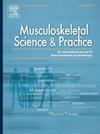Differences in tactile grid localization accuracy between people with back pain compared to individuals without pain
IF 2.2
3区 医学
Q1 REHABILITATION
引用次数: 0
Abstract
Objectives
The study aimed to investigate the grid localization test (GLT) between patients with lower back pain and those without back pain.
Methods
Individuals receiving physical therapy were tested before treatment with a GLT to the low back. Testing was performed in the prone position. Participants were oriented to the 12-box, 50 mm grid squares, arranged in three rows and four columns, with a single touch in the center of each square, and provided with the corresponding number for that square. Twenty random touch points were then applied with a single touch in the center of the square, and the participant's accuracy in reporting the correct number associated with the touched square was recorded.
Results
GLT was done on 26 individuals with lower back pain compared to 26 individuals without back pain. Those with back pain had a mean accuracy score of 52.41 %, compared to those without back pain, who averaged 76.18 % accuracy, adjusted for age as a covariate between groups. This was a significant difference (p < 0.001) that demonstrated a large effect size (partial η2 = 0.296). Interestingly, those with acute pain (<3 months) scored (n = 14, mean = 48.9 %, SD = 21.2 %), similarly to those with chronic pain (>3 months) (n = 12, mean = 49.2 %, SD = 20.3 %).
Discussion
When tested with GLT, individuals with low back pain exhibit poorer accuracy scores compared to those without pain. Future studies are needed to determine if treatment to improve accuracy scores has therapeutic benefits.
有背痛的人和没有背痛的人在触觉网格定位准确度上的差异
目的探讨下背部疼痛患者与非下背部疼痛患者的网格定位测试(GLT)。方法对接受物理治疗的个体进行下背部GLT治疗前的检测。试验采用俯卧位。参与者被引导到12个盒子,50毫米的网格正方形,排列成三排四列,在每个正方形的中心有一个触摸,并提供相应的正方形数字。20个随机的触摸点,然后在正方形的中心进行一次触摸,参与者报告与触摸正方形相关的正确数字的准确性被记录下来。结果glt对26名腰痛患者和26名无腰痛患者进行了对比。有背痛的患者平均准确率为52.41%,而没有背痛的患者平均准确率为76.18%,根据年龄作为组间协变量进行了调整。这是一个显著的差异(p < 0.001),证明了一个大的效应量(偏η2 = 0.296)。有趣的是,急性疼痛(3个月)患者得分(n = 14,平均= 48.9%,SD = 21.2%),与慢性疼痛(3个月)患者相似(n = 12,平均= 49.2%,SD = 20.3%)。当进行GLT测试时,与没有疼痛的人相比,有腰痛的人表现出更低的准确性得分。未来的研究需要确定提高准确性评分的治疗是否有治疗效果。
本文章由计算机程序翻译,如有差异,请以英文原文为准。
求助全文
约1分钟内获得全文
求助全文
来源期刊

Musculoskeletal Science and Practice
Health Professions-Physical Therapy, Sports Therapy and Rehabilitation
CiteScore
4.10
自引率
8.70%
发文量
152
审稿时长
48 days
期刊介绍:
Musculoskeletal Science & Practice, international journal of musculoskeletal physiotherapy, is a peer-reviewed international journal (previously Manual Therapy), publishing high quality original research, review and Masterclass articles that contribute to improving the clinical understanding of appropriate care processes for musculoskeletal disorders. The journal publishes articles that influence or add to the body of evidence on diagnostic and therapeutic processes, patient centered care, guidelines for musculoskeletal therapeutics and theoretical models that support developments in assessment, diagnosis, clinical reasoning and interventions.
 求助内容:
求助内容: 应助结果提醒方式:
应助结果提醒方式:


